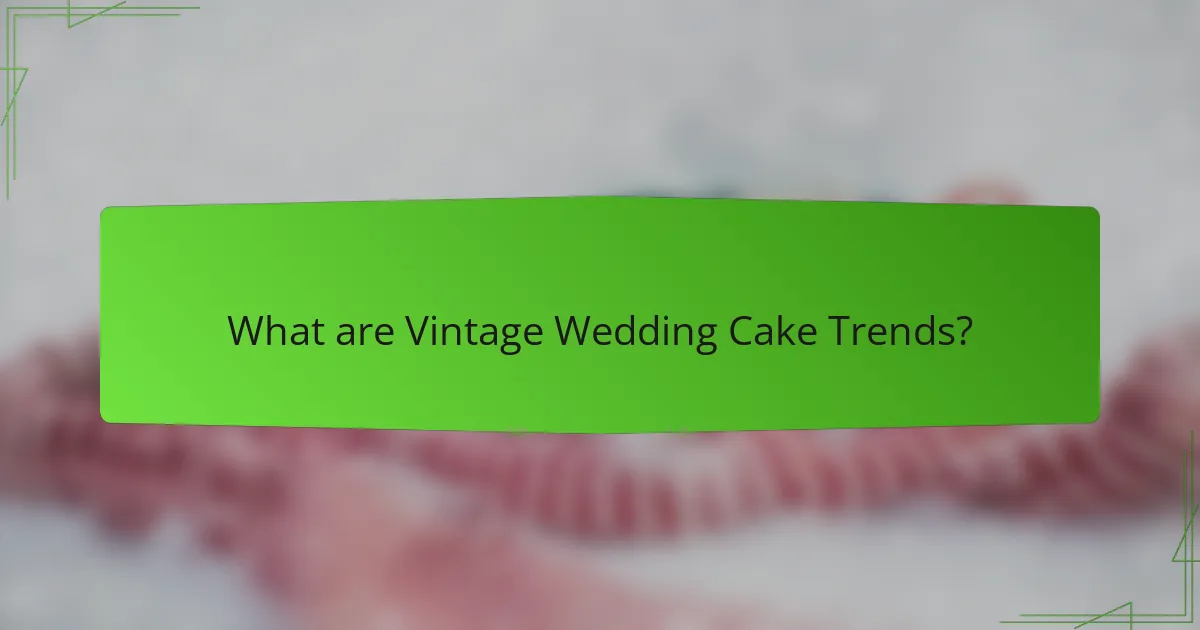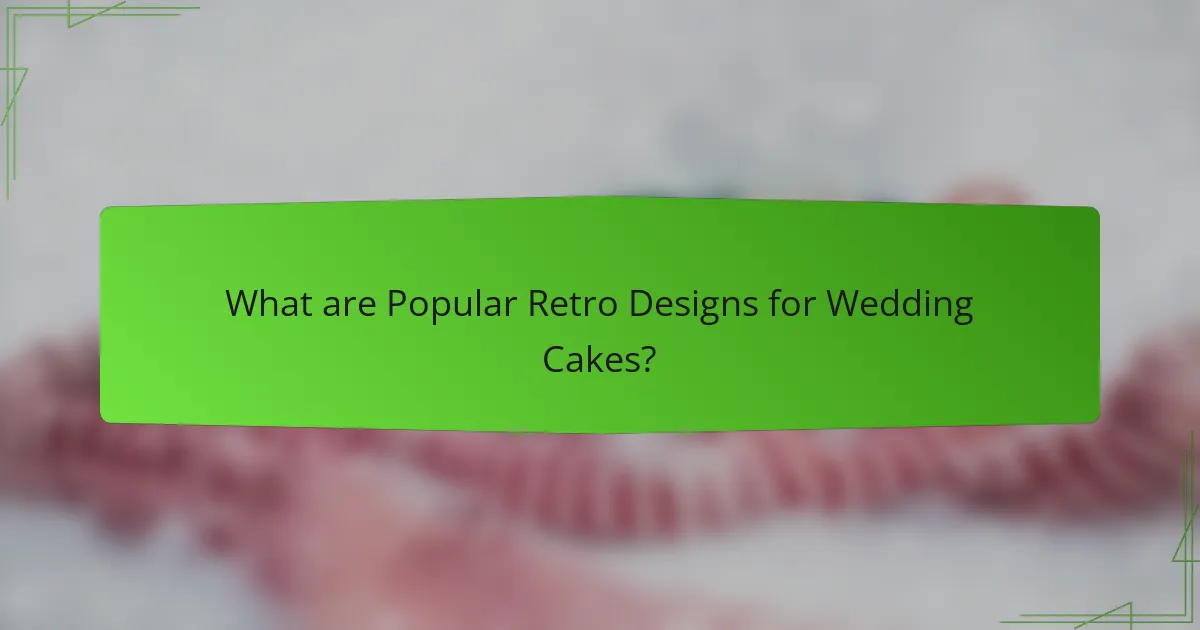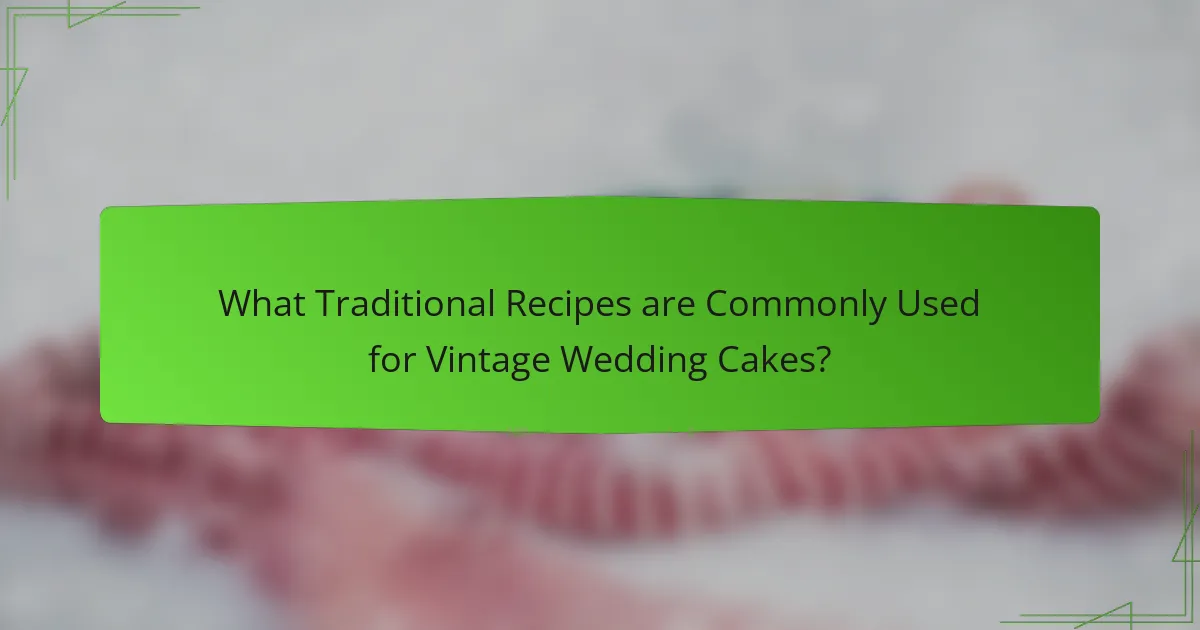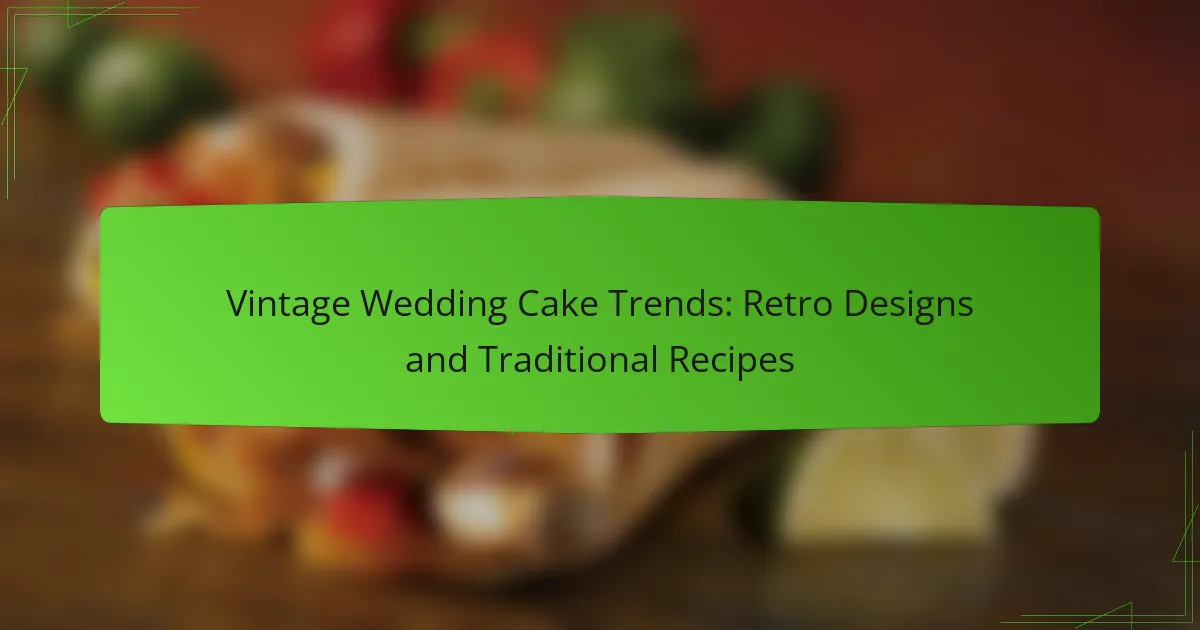
What are Vintage Wedding Cake Trends?
Vintage wedding cake trends include intricate lace patterns, floral designs, and rustic finishes. These cakes often feature vintage-inspired flavors such as fruitcake or red velvet. Additionally, popular elements include pastel colors and tiered designs. Many couples are opting for personalized cake toppers that reflect their unique story. The use of natural ingredients and organic decorations is also on the rise. According to wedding industry reports, vintage cakes have gained popularity due to their nostalgic appeal. This trend reflects a broader movement towards personalized and meaningful wedding celebrations.
How have vintage wedding cake trends evolved over time?
Vintage wedding cake trends have evolved significantly over time. Initially, wedding cakes were simple and often fruit-based. In the Victorian era, elaborate designs became popular, showcasing intricate sugar work and multiple tiers. The 1920s introduced art deco influences, leading to geometric patterns and bold colors. In the mid-20th century, cakes began to feature more personalized themes, reflecting the couple’s unique story. The 1980s and 1990s saw a rise in the use of fondant, allowing for smoother finishes and more elaborate decorations. Recently, there has been a resurgence of retro styles, with couples opting for vintage designs that incorporate traditional recipes and rustic elements. This evolution reflects changing tastes and the desire for personalization in wedding celebrations.
What historical influences shape vintage wedding cake designs?
Vintage wedding cake designs are shaped by various historical influences. The Victorian era introduced intricate designs and elaborate decorations. Cakes became multi-tiered, symbolizing wealth and status. The use of fondant and royal icing emerged during this time, allowing for detailed artistry. Art Deco in the 1920s brought geometric shapes and bold colors to cake design. The post-World War II era saw simpler, more romantic styles reflecting changing social norms. Cultural traditions also play a role, with regional variations influencing flavor and decoration. These historical trends continue to inspire modern vintage cake designs.
How do cultural factors impact vintage wedding cake trends?
Cultural factors significantly influence vintage wedding cake trends. Different cultures have unique traditions and symbols associated with weddings. These traditions often dictate the design, flavors, and ingredients used in wedding cakes. For instance, in some cultures, fruitcakes are favored for their symbolism of prosperity. In contrast, others may prefer sponge cakes for their lightness and versatility. Historical context also plays a role; certain designs may reflect the aesthetic values of specific eras. Additionally, regional availability of ingredients can shape cake recipes and styles. The resurgence of vintage aesthetics in popular culture further drives interest in traditional designs. This interplay of cultural practices and historical influences shapes the evolving trends in vintage wedding cakes.
What are the key characteristics of vintage wedding cakes?
Vintage wedding cakes are characterized by intricate designs, traditional flavors, and multi-tiered structures. These cakes often feature delicate lace patterns and floral decorations, reflecting the elegance of past eras. Common flavors include vanilla, almond, and fruitcake, which were popular in historical wedding celebrations. The use of fondant and buttercream is prevalent for a smooth finish. Additionally, vintage cakes may incorporate vintage cake toppers, such as figurines or floral arrangements. Their presentation often includes ornate cake stands to enhance visual appeal. The overall aesthetic aims to evoke nostalgia and charm, making them a timeless choice for weddings.
What design elements define a vintage wedding cake?
Vintage wedding cakes are characterized by intricate details and nostalgic elements. Common design features include lace patterns, floral decorations, and soft color palettes. These cakes often use fondant or buttercream to create a smooth finish. Ruffles and tiers are popular, adding elegance and height. Vintage cakes frequently incorporate antique cake stands for display. Edible pearls and gold leaf are used for added sophistication. Many vintage designs draw inspiration from historical eras, such as the Victorian or Art Deco periods. These elements combine to evoke a sense of romance and timelessness in vintage wedding cakes.
How do flavors and ingredients differ in vintage wedding cakes?
Flavors and ingredients in vintage wedding cakes often reflect traditional recipes and regional influences. Common flavors include vanilla, almond, and lemon, which were popular in earlier decades. Ingredients like butter, sugar, and eggs are foundational, as they create rich textures. Vintage cakes may also feature fruit preserves or nuts for added flavor and texture.
Spices such as cinnamon and nutmeg are sometimes included, enhancing the cake’s aroma and taste. Traditional cakes often use less artificial flavoring compared to modern recipes. The use of fondant and royal icing is prevalent for decoration in vintage styles. These elements contribute to a nostalgic and classic aesthetic that distinguishes vintage wedding cakes from contemporary options.

What are Popular Retro Designs for Wedding Cakes?
Popular retro designs for wedding cakes include vintage lace patterns, art deco styles, and classic tiered cakes. Vintage lace patterns often feature intricate piped designs that mimic lace fabric. Art deco styles are characterized by geometric shapes and bold colors, reflecting the 1920s aesthetic. Classic tiered cakes typically have a simple yet elegant design, often adorned with fresh flowers or fruit. These designs evoke nostalgia and are favored for their timeless appeal. Historical records show that these styles have been popular in wedding celebrations since the early 20th century.
What are the most sought-after retro cake designs today?
The most sought-after retro cake designs today include classic tiered cakes, vintage floral patterns, and polka dot designs. Classic tiered cakes often feature intricate lace detailing and pastel colors. Vintage floral patterns showcase hand-painted or piped flowers reminiscent of the 1950s and 1960s. Polka dot designs are popular for their playful and nostalgic appeal. Additionally, buttercream finishes and bold geometric shapes are trending in retro cake styles. These designs reflect a growing interest in nostalgia and vintage aesthetics among couples planning weddings.
How do tiered cakes reflect vintage aesthetics?
Tiered cakes reflect vintage aesthetics through their elaborate designs and historical significance. These cakes often feature multiple layers, symbolizing abundance and celebration. The use of intricate decorations, such as lace patterns and floral motifs, evokes a sense of nostalgia. Vintage tiered cakes typically incorporate classic flavors like fruitcake or buttercream. Historical wedding traditions often included tiered cakes as a centerpiece, enhancing their cultural importance. The craftsmanship involved in creating these cakes highlights artisanal skills from past eras. Additionally, the color palettes used often consist of soft pastels or muted tones, aligning with vintage styles. Overall, tiered cakes serve as a visual representation of vintage elegance and tradition.
What role do cake toppers play in retro designs?
Cake toppers play a significant role in retro designs by enhancing the nostalgic aesthetic of vintage wedding cakes. They serve as focal points that reflect the era’s style, often featuring classic motifs or characters. Retro cake toppers can include figurines, floral arrangements, or monograms that evoke a sense of tradition. These elements contribute to the overall theme of the cake, making it visually appealing and memorable. Historically, cake toppers became popular in the early 20th century, symbolizing celebration and unity. Their use in retro designs helps to transport guests back to a simpler time, creating a warm and inviting atmosphere. The incorporation of these toppers often complements the cake’s flavor and decoration, reinforcing the vintage theme.
How can couples incorporate vintage styles into their wedding cakes?
Couples can incorporate vintage styles into their wedding cakes by choosing classic designs and flavors. Popular vintage cake styles include tiered cakes with intricate lace patterns. Fondant can be used to create a smooth, elegant finish reminiscent of the past. Couples might also opt for vintage-inspired cake toppers, such as figurines or floral arrangements. Traditional flavors like fruitcake or red velvet can evoke a sense of nostalgia. Using pastel colors or muted tones can enhance the vintage aesthetic. Additionally, incorporating heirloom cake stands can add a charming touch. These elements collectively contribute to a vintage-inspired wedding cake that reflects historical styles.
What color palettes are popular for vintage wedding cakes?
Popular color palettes for vintage wedding cakes include pastel shades, muted tones, and earthy hues. Soft pinks, light blues, and creamy yellows are commonly used. These colors evoke a nostalgic feel, aligning with vintage aesthetics. Additionally, rich jewel tones like emerald green and deep burgundy are also favored. These palettes often incorporate gold or silver accents for elegance. The popularity of these colors is supported by trends in vintage-themed weddings. Research indicates that pastel colors have been a consistent choice in wedding cake designs over recent years.
How can floral arrangements enhance vintage cake designs?
Floral arrangements can significantly enhance vintage cake designs by adding color, texture, and elegance. Flowers complement the intricate details often found in vintage cake styles. They create a harmonious visual balance, drawing attention to the cake’s design elements. Fresh or dried flowers evoke a sense of nostalgia, aligning with the vintage theme. Specific flower choices, like peonies or roses, can reflect historical aesthetics. Floral arrangements can also provide a natural contrast to the cake’s frosting and decorations. This combination results in a more visually appealing centerpiece for events. Overall, floral arrangements enrich the overall presentation and thematic consistency of vintage cakes.

What Traditional Recipes are Commonly Used for Vintage Wedding Cakes?
Traditional recipes commonly used for vintage wedding cakes include fruitcake, sponge cake, and buttercream cake. Fruitcake is dense and rich, often containing dried fruits and nuts. This cake has been a classic choice for centuries, especially in British weddings. Sponge cake is light and airy, made with eggs, sugar, and flour. It serves as a versatile base for various fillings and frostings. Buttercream cake features a sweet, creamy frosting that can be flavored and colored. These recipes reflect historic baking traditions and are favored for their flavors and textures.
What classic flavors are associated with vintage wedding cakes?
Classic flavors associated with vintage wedding cakes include almond, vanilla, and lemon. Almond flavor provides a rich, nutty taste that complements traditional recipes. Vanilla is a timeless choice, known for its versatility and sweetness. Lemon adds a refreshing zing, balancing the sweetness of the cake. Other popular flavors are chocolate and fruitcake, which were often used in earlier wedding traditions. These flavors reflect the nostalgic essence of vintage wedding cakes, appealing to couples seeking a classic celebration.
How do traditional recipes differ from modern cake recipes?
Traditional cake recipes often emphasize natural ingredients and time-consuming methods. They typically use basic components like flour, sugar, eggs, and butter. In contrast, modern cake recipes frequently include convenience ingredients such as baking powder and pre-mixed cake mixes. Traditional recipes may require techniques like creaming butter and sugar for longer periods. Modern recipes often simplify this process, allowing for quicker preparation.
Additionally, traditional cakes often feature rich flavors and textures, relying on techniques passed down through generations. Modern cakes may prioritize variety and innovation, incorporating trendy flavors and decorations. Historical context shows that traditional recipes were developed in home kitchens, while modern recipes often originate from commercial kitchens and culinary schools.
These differences highlight a shift in baking culture, reflecting changing lifestyles and consumer preferences.
What are the most popular cake bases for vintage wedding cakes?
The most popular cake bases for vintage wedding cakes are fruitcake, sponge cake, and buttercream cake. Fruitcake is a classic choice, often used in traditional weddings. It is dense and rich, typically made with dried fruits and nuts. Sponge cake is light and airy, making it a versatile option for various fillings and frostings. Buttercream cake offers a moist texture and is easy to decorate, aligning well with vintage aesthetics. These bases are commonly selected for their flavors and textures that complement vintage designs.
How can bakers adapt traditional recipes for modern tastes?
Bakers can adapt traditional recipes for modern tastes by incorporating contemporary ingredients and techniques. They can substitute refined sugars with natural sweeteners like honey or maple syrup. Using alternative flours, such as almond or coconut flour, caters to gluten-free diets. Bakers can also reduce the fat content by using applesauce or yogurt in place of butter.
Incorporating seasonal fruits enhances flavor and freshness. Adjusting spice levels can align with current flavor trends. Bakers can experiment with new flavor combinations, such as matcha or lavender, to attract modern palates. Finally, they can focus on presentation, using minimalist designs that reflect current aesthetic preferences.
What are some tips for balancing vintage flavors with contemporary preferences?
Incorporating vintage flavors into contemporary wedding cakes can be achieved through thoughtful adjustments. Start by selecting traditional recipes that highlight classic flavors, such as almond or lemon. Modernize these flavors by using lighter textures, such as chiffon or sponge cakes, instead of denser options.
Consider pairing vintage flavors with contemporary fillings, like fruit compotes or whipped creams, to create a refreshing contrast. Use fresh, seasonal ingredients to enhance the overall taste and appeal.
Presentation is key; opt for minimalist designs that showcase the vintage flavors without overwhelming them. This approach aligns with current trends favoring simplicity and elegance in cake design.
Research indicates that couples often seek a blend of nostalgia and modernity in their wedding cake choices. A survey by The Knot found that 60% of couples prefer unique flavors that reflect their personalities while still honoring tradition.
How can dietary restrictions be accommodated in vintage cake recipes?
Dietary restrictions can be accommodated in vintage cake recipes by substituting traditional ingredients with suitable alternatives. For gluten-free diets, almond or coconut flour can replace wheat flour. For dairy-free options, plant-based milk and vegan butter can be used instead of cow’s milk and butter. Egg replacements like flaxseed or applesauce can substitute eggs for those with egg allergies. Additionally, sugar alternatives such as agave syrup or stevia can be used for those needing reduced sugar. These modifications retain the essence of vintage recipes while catering to various dietary needs. Many bakers successfully adapt vintage recipes for modern dietary preferences, demonstrating the versatility of classic cakes.
What are some best practices for creating a vintage wedding cake?
To create a vintage wedding cake, focus on traditional flavors and intricate designs. Use classic ingredients like fruit, nuts, and spices for authentic taste. Incorporate elements such as lace, floral patterns, or vintage figurines for decoration. Choose pastel colors or muted tones to enhance the vintage aesthetic. Layering techniques should reflect historical styles, such as tiered or stacked designs. Consider using fondant for a smooth finish that can mimic vintage textiles. Ensure the cake is well-structured for stability, especially with multiple tiers. Research historical cake recipes for authenticity, as vintage cakes often have unique flavor profiles.
Vintage wedding cake trends encompass retro designs and traditional recipes characterized by intricate lace patterns, floral decorations, and tiered structures. Popular flavors include fruitcake, almond, and vanilla, reflecting historical preferences. The article explores the evolution of these trends, the impact of cultural factors, and key design elements that define vintage cakes. It also discusses how couples can incorporate vintage styles into their wedding cakes, adapt traditional recipes for modern tastes, and accommodate dietary restrictions while maintaining authenticity.
